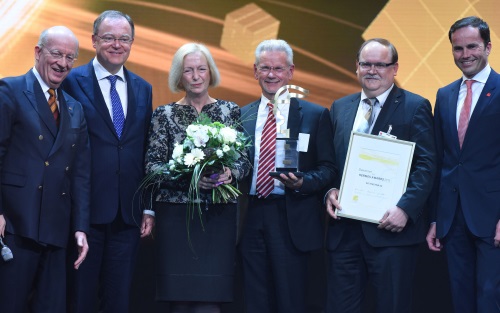
Presentation ceremony for the winners of the HERMES AWARD 2015 Dr. Manfred Wittenstein, Chairman of the Supervisory Board of WITTENSTEIN AG (3rd from right), and Thomas Bayer, Head of Generating Process Management at WITTENSTEIN AG (2nd from right), with Professor Johanna Wanka (3rd from left), Professor Wolfgang Wahlster (far left), Stephan Weil, state premier of Lower Saxony (2nd from left), and Dr. Jochen Köckler (right).
WITTENSTEIN has won the 2015 Hermes Award at this year’s Hannover Faire in Germany. Chosen from a field of almost seventy entrants from ten different countries, WITTENSTEIN won the award for its revolutionary new Galaxie Drive System. Deutsche Messe’s annual Hermes Award technology prize is open to all companies and institutions exhibiting at the Hannover Messe and is the world’s most important industrial award.
Professor Johanna Wanka (Federal Minister of Education and Research) and Professor Wolfgang Wahlster, Jury Chairman and Scientific Director of the German Research Center for Artificial Intelligence (DFKI), presented the award to Dr. Manfred Wittenstein, Chairman of the Supervisory Board of WITTENSTEIN AG, and Thomas Bayer, Head of Galaxie Drive Systems at WITTENSTEIN AG on April 12, 2015 when the Hannover Messe was officially opened in the presence of Chancellor Angela Merkel.
The Galaxie Drive System presented by WITTENSTEIN introduces a brand new gearhead generation. The gearhead has been fused with a newly developed motor to obtain an ultra-compact, hollow-shaft drive system with integrated Industry 4.0 connectivity. It has a measured efficiency of more than 92% and sets new yardsticks in all technical disciplines.
“This year’s award winner demonstrates that even in the digital age, springboard innovations are still possible, even when it comes to the basic fundamentals of motion in industrial drives. Our jury unanimously chose WITTENSTEIN’s Galaxie gearhead as the winner because it leverages a radically new gear tooth principle – the logarithmic spiral, which occurs in nature in the form of a snail’s shell, for example – in order to provide a new kind of high performance drive system without a gear wheel that features integrated sensors and networking”, said Professor Wolfgang Wahlster, Chairman of the Jury.
Dr. Jochen Köckler, member of the managing board at Deutsche Messe, continued: “WITTENSTEIN is synonymous with technological expertise and innovative spirit. The company has been exhibiting at Hannover Messe for many years and, year after year, has been showcasing new products in the field of high precision electromechanical drives. The winning product is a completely new type of gearhead featuring Industry 4.0 connectivity.”
Explaining the revolutionary aspects of the system, Thomas Bayer noted, “The Galaxie Drive System will open more new doors for development engineers than any invention during the last several decades.”
An ingenious idea: the Galaxie gearhead’s kinematics
Professor Wanka was equally excited by Galaxie’s innovative core – namely the completely redesigned gearhead kinematics – which ultimately made quite an impression on the HERMES AWARD jury: “Everyone knows what a gear wheel looks like – and now, out of the blue, we’re suddenly confronted with the idea of building a gear with moving teeth. You won’t find it in any textbook, but it works!” For the first time ever, a gearhead dispenses completely with a gear wheel – instead, each of the teeth involved in torque conversion is an independent and dynamic entity, which is supported by a needle roller bearing, grouped around a two or three-cam input polygon and guided along the teeth of a ring gear. As a result of this ingenious principle, almost all of the teeth now engage simultaneously – compared to only a few with traditional gear types.
The new “tooth contact” – for unlimited power
Thanks to the new engagement principle, the tooth contact is no longer a line but a surface. The outcome: the Galaxie gearhead kinematics give a tooth contact surface which is 6.5 times larger than with a helical-toothed planetary gearhead, for example. What’s more, the teeth in contact are automatically aligned because they are guided cylindrically in the tooth carrier, leading to optimal engagement with the internal gear teeth – and an optimal transverse load distribution. Another defining feature is the hydrodynamic lubrication film that is built up automatically here by the multiple teeth in surface contact – even at low speeds and up to very high torque loads. Mechanical wear and abrasion are reduced to a minimum and once the torsional backlash has been set, it remains absolutely constant throughout the lifetime of the equipment.
Galaxie is light years ahead
The Galaxie Drive System represents a paradigm shift in electric drive technology and a radical innovation with far-reaching technological consequences – a claim that is also backed up by its performance features*:
Maximum torque: +70 … +170%
Emergency stop torque: +150 …+300%
Torsional rigidity: +340 …+580%
Hollow shaft / outer diameter: +3 …+70%
Efficiency: +18 …+29%
*Compared to the market standard for similar sizes.
What WITTENSTEIN was looking for was everything at once and much, much better: the new Galaxie gearhead generation – which has yet to feature in any textbook – and the Galaxie Drive System it inspired are light years ahead of all gear principles today, regardless of the drive engineering discipline. “The first successful applications have already been realized”, Volker Sprenger, Head of Sales Galaxie Drive Systems, confirmed. Several Galaxie Drive Systems are already in production use in lathes, rolling machines, milling and machining portals, etc. – and even as steering units in sounding rockets.
“The fact that all candidates for the HERMES AWARD 2015 showed such a very high degree of innovation further underlines what an exceptional pioneering achievement the Galaxie Drive System represents in the field of mechatronic drive technology”, said Professor Dieter Spath, Chairman of the Board and CEO WITTENSTEIN AG.
WITTENSTEIN AG
http://www.wittenstein-us.com/
Filed Under: Motors (gearmotors)


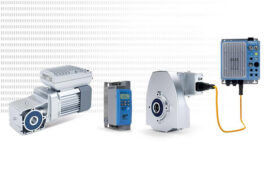
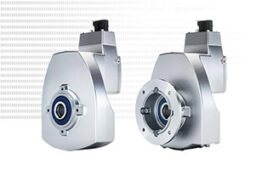
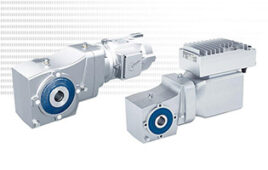
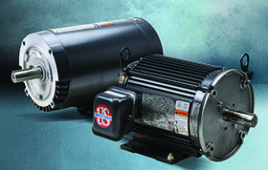
Tell Us What You Think!